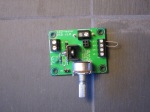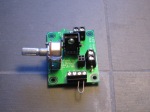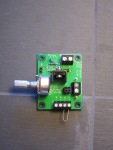LED-tester deluxe…
March 22, 2017 3 Comments
A few months ago I stumbled upon a presentation thread for an “LED-tester” circuit by Muffsy-creator H. Skrodahl on a Norwegian audio forum. Two things immediately occured to me:
1) I want one!
2) I think I can improve this a bit 😀
So rather than simply downloading his posted Eagle files and ordering boards from there, I started doing my own board instead. With the final result arriving earlier this week it’s time to put it to the test.
The basic idea is to use an LM317 regulator as a variable Constant Current Source (CCS) to test unidentified LEDs and confirm what currents are required for acceptable brightness – something that isn’t always easy to guess based on the published specs. I’ve kept the basic circuit intact but my modifications basically consist of:
– “Real” connectors for all connections instead of just solderpads.
– Additional outputs for LED connections to allow direct plugging in, permanent wired connections and also temporary connections via test leads/crocodiles clips.
– Space for a stereo pot to give a bit more mechanical stability.
– Optional “high-current” mode for testing constant-current LED bulbs as a supplement to just normal LEDs.
– Four real mounting holes to allow the board to be fixed to a bit of scrap metal or similar for use in a lab environment.
I need to do a bit more validation on the prototype before I publish my board files, but at least I can confirm that it works and that it is a very useful way to identify the operating parameters of e.g. LEDs in pushbutton switches.



Cool adaptation of the project. I liked the idea of using the LM317 as a constant current source and ran with it to scratch my itch, this is much more well thought out.
I’ll be adding miniature volt- and ammeters to mine when I find the time for it. 🙂
Thanks, but it’s always easier to improve on an existing design than to build from scratch 🙂
Using the LM317 as a CCS is something that is underutilised in my opinion, because it greatly expands the allowable supply range without any real drawbacks so I will continue to use this in more projects 😀
Pingback: Project files: LED tester | theslowdiyer